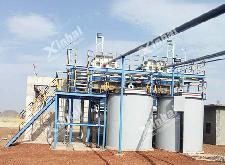

Warm Tip: If you want to know more details about equipment, solutions, etc, please click the button below for free consultation, or leave your requirements!
.jpg)
Slime is a kind of solid waste produced by mining, generally refers to 5-10 micron ore particles. The slime has a great adverse effect on the beneficiation process, and it is necessary to treat the slime bearing ore before the beneficiation operation to reduce or eliminate the harmful effects of the slime. We will explain in detail below.
To understand how to deal with slime bearing ore, we must first understand the reasons for the formation of slime.
According to the source, the slime can be divided into two types: the slime produced by geological action in the ore deposit is called primary slime; the slime produced in the process of ore grinding and crushing is called secondary slime.
In addition to the large amount of mud in the deposit itself, there are two other reasons for the formation of slime: one is the transportation and crushing process, which are the main reasons; the second is when mining, due to the increase of inter-pillar stopes, the part of the filling body of slope collapsed and mixed with the ore to become non-metallic slime.
In addition to the slime mentioned above, there is also a material composition that affects the production and indicators of mineral processing called lost middling (also known as recycled slime), which comes from the loss of ground sewage in mineral processing, maintenance lost and leakage. The amount of metal in the lost middling and slime accounts for a large proportion of the raw ore, and contains a lot of oil and reagent. The composition is complex and difficult to separate.
The slime has adverse effects on the cyanidation and flotation of ore.
In the cyanidation of slime-containing gold ore, the slime would:
1) Make the concentration and filtration of pulp difficult;
2) Reduce the dissolution rate of gold;
3) Because the slime can absorb the dissolved gold, it is unfavorable for the washing of gold-containing solution and the replacement and precipitation of zinc powder.
1) Before cyanidation, wash the gold-containing material with water to remove soluble compounds (copper sulfate, iron salts, acid, flotation reagent and slime).
2) When performing cyanidation on slime-bearing gold ore and its concentrate, we can use ion exchange resin or activated carbon to directly adsorb the dissolved gold from the cyanide slurry.
In the flotation of slime-containing ore, the slime would:
1) Increase the consumption of flotation reagents;
2) Make the flotation process complicated;
3) Reduce the quality of concentrate.
1) Use coagulants and flocculants to improve the condensability and filterability of the ore.
2) Use various inhibitors (water glass, starch, carboxymethyl cellulose, polyacrylamide) to inhibit the flotation of the slime. When concentrating the flotation coarse concentrate, these reagents can also be used to inhibit the slime.
3) Add collector and foaming agent in batches so that flotation can be carried out in stages. Through concentration, each stage can obtain the finished concentrate.
4) Preliminarily treat the ore with a collector, and then perform flotation.
5) Prioritize flotation of slime and sulfide. We can use ethanol or pine oil for the flotation of slime and use sulfhydryl collectors for the flotation of gold and sulfide.
In addition to the above targeted methods, we can also directly deslime the ore.
This method is very effective, it can greatly improve the index of the next flotation and cyanidation process.
The desliming operation can be divided into two stages. One is the dissociation and dispersion of slime, the other is the separation of slime and sand. These two stages can be carried out separately or simultaneously.
The equipment used mainly including desliming bucket, hydrocyclone, thickener, spiral classifier, washing machine, hydraulic separator, etc.
One of the main purposes of desliming is to improve the flotation and filtration effects.
Under certain flotation conditions, there is an optimal particle size composition. Flotation with this particle size composition can maximize the yield of concentrates and reduce the loss of combustibles in the tailings, improve the overall flotation efficiency, and also greatly improve the concentrate filtering effect.
The degree of desliming can be determined by studying the optimal particle size composition of the flotation feed.
In practice, we can control the degree of desliming by controlling the underflow concentration of the raw ore desliming thickener.
The slime removed has a particle size of -10μm, which is difficult to be recovered by gravity separation, magnetic separation and flotation, so it is generally discarded as tailings.
The above are the formation reasons, harmful effects, and solutions of slime. In actual production, you can refer to the above measures to treat slime-bearing ore to achieve the highest production efficiency.
If you have any questions, please feel free to consult the online customer service or leave a message at the bottom of the screen to discuss with us.
14 Reasons and Solutions of Poor Gold Leaching Effect
 0
0
 4985
4985


What Are the Differences Between CIP and CIL?
 11281
11281
 0
0